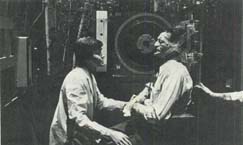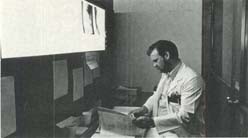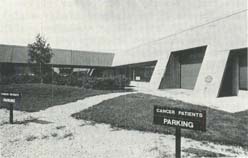Neutrons Against Cancer: Fermilab Cancer Therapy Facility
INTRODUCTION
Modern medicine employs three primary forms of cancer treatments: surgery, chemotherapy (medication), and radiation therapy. The location, type, and size of the cancer determine the treatment method(s). In many cases, varying combinations of the three types of treatment are used.
A new type of radiation therapy, called neutron therapy, is being offered as an experimental program at Fermilab. To conduct this research, the Laboratory has established a Cancer Therapy Facility (CTF).
This research program, together with three other centers in the United States, tests the effectiveness of neutron beams by comparing them with conventional radiation in the management of certain tumors.
RADIATION THERAPY
In radiation therapy, penetrating rays are used to treat cancerous tumors. The rays may come from x-ray machines, from radioactive substances, or from accelerators (machines that speed up subatomic particles).
Basically, radiation therapy destroys cells. The treatment is designed to destroy as many cancerous cells as possible, while doing the least harm to normal cells. During therapy both cancerous and normal cells die. However, the healing mechanisms of the body replace the dead normal cells.
The success of a treatment is measured by the extent of tumor eradication versus the damage to the surrounding normal tissues. A patient's response to treatment depends on the nature and extent of the tumor.
NEUTRON THERAPY
The Fermilab CTF opened in September 1976. It evolved from studies on laboratory animals and patients who have undergone neutron therapy here, elsewhere in the United States, and across the world.
Neutrons are particles found in the heart of every atom -the nucleus. Neutrons act on human tissues much like x-rays. These radiations destroy cells by changing their genetic character and thus creating offspring that cannot survive. There are, however, some cells in the tumor that are oxygen deficient (hypoxic cells) and these are known to be resistant to the effects of x-rays.
These cells are believed to be responsible for the reappearance of the tumor after conventional (x-ray) therapy. Hypoxic cells are not "resistant" to fast neutrons. Hence, the use of this beam will hopefully increase tumor control. This, however, must be scientifically proven.
Cancers treated in the program are those in which conventional therapy is unlikely to provide control. Possibilities are that neutron results will be better or similar to conventional radiation. Patients who participate help the advance of medical knowledge by establishing the effectiveness of this new therapy.
Those who have offered to participate in these studies may at any time choose not to be a part of this project or may withdraw before completing neutron treatments.
These patients may then continue their treatment with conventional therapy. An institutional review board (IRB) reviews proposed studies and decides if potential benefits exceed risks for the patients. In addition, the IRB assures adequate protection of the rights and privacy of patients. Fermilab's IRB comprises three out-of-town radiotherapists, a medical physician, an attorney, two medical oncologists, a social worker, an oncollogical nurse, and a professor of theology.
The cancers treated are described in study protocols designed by a national group of radiation therapists under the auspices of the National Cancer Institute. Patients are referred by a radiation therapist to the study only if they have been identified as having a suitable cancer which will benefit from fast neutron therapy. This further assures that the neutron treatment is in the best interest of the patient.
Certain tumors of the mouth and upper respiratory passages, advanced cancers of the cervix, prostate, bladder, and some brain cancers are being treated at U.S. neutron centers. In addition, at Fermilab some cancers of the lung and pancreas as well as certain bone and soft tissue malignancies are irradiated in conjunction with surgery and chemotherapy.
Treatment with neutrons is delivered in a sitting or standing position. Special devices are used to correct the position and immobilize patients. Treatments including set-up and irradiation require twenty to thirty minutes depending on the region of the body involved. During treatment the patient is observed by closed circuit television and communication is maintained by an intercom system. Generally, treatment is given one to four times a week and may last from three to seven weeks.
After the course of neutron therapy at Fermilab is completed, the patient returns to his referring physician and radiotherapist for evaluation and follow up. Patients are also asked to report periodically at Fermilab for check-ups. These follow-ups at Fermilab are done without charge.
As each patient contributes to the research, all data are recorded and sent for analysis by modern computer techniques. Personal privacy is assured. Patients' identities are unknown to statistician and research workers evaluating results. Physicians and allied scientists participating in this study across this country have access to results and are able to get valuable information from the study.
TREATMENT EFFECTS
The effects of neutron treatment, like all radiation therapy, depend on the part of the body being treated. Effects on normal tissues are minimized by careful planning and by dividing the total radiation dose into many fractions. Some side effects may be anticipated. Many of these side effects are transient and tissue recovery occurs with time.
FACILITIES
Fermilab operates the most powerful particle accelerator in the world. It was built for high energy physics research. The Cancer Therapy Facility is possible at Fermilab because injector equipment in the linear accelerator is used for only about 30% of the time to supply protons for physics research. During the remaining time, the injector system is available for use by the CTF for cancer treatment, typically seven out of every ten seconds.
To create the CTF, a small area parallel to the linear accelerator was remodeled. After a year of initial dosimetry and radiobiology studies, patient therapy was started in September, 1976. It contains the heavily-shielded treatment room and other rooms for reception, examination, and controls. The facility is easily accessible to patients through a nearby outside ground level door.
The treatment room has two levels. An upper one is designed for access and contains x-ray diagnostic equipment used to confirm that the patient is properly placed with respect to the X beam. Then the platform is lowered and the patient is placed in the neutron beam at the treatment point. This point at the lower level is defined by four lasers.
Neutrons are produced in all directions when protons diverted from the linear accelerator strike a beryllium target. An absorbing wall with appropriately-tapered holes is placed between the neutron source and the patient. The proper hole assures that only the part of the body that the physician wants to treat will be actually irradiated. The patient is precisely positioned in the neutron beam with the help of the beam lights (lasers).
Neutron beam therapy is suitable for patients who are ambulatory. Patients walk into the treatment room and must be able to hold their treatment position for the duration of therapy. While the Cancer Therapy Facility has a full medical and nursing staff, there are no inpatient beds. In case of an emergency, a patient at Fermilab is taken to a nearby hospital for immediate care. If inpatient care is needed, the patients are referred back to their original hospitals and the therapy is interrupted or they may come to Fermilab in an ambulance.
COST
No charge is made to patients for the use of the beam or the facilities at Fermilab. Patients have to arrange for their own transport. Sometimes the Illinois Cancer Council and volunteers of the American Cancer Society help in patient transport.
FUNDING
Beginning June 13, 1975 the National Cancer Institute (U. S. Dept. of Health, Education, and Welfare) granted $816,000 for three-year operating funds for the CTF. After an independent on-site review, NCI awarded a second three-year grant effective August 1, 1977 of $2,186,953, for operating expenses. The Illinois Division of the American Cancer Society has made two research and instrumentation grants totalling slightly over $35,000 to finance dosimetry equipment, beam time, travel and other expenses.
Through the efforts of the medical profession in the Chicago area, led by Dr. Samuel Taylor III, private funds were contributed for building modifications to accommodate the new facility and for some equipment. The Field Foundation donated $50,000; the Joyce Foundation $50,000; the A. B. Dick Company $50,000; the Chicago Trust (through Harry L. and Elizabeth Marshall, Dr. Adolph Gehrmann, and the William Allen Pusey Fund) $50,000; Elliott Donnelley $10,000; Robert R. McCormick Charitable Trust $50,000; Amoco Foundation $10,000; Metropolitan Association of Radiation Therapists $106. Private individuals have donated close to $5,000.
HISTORY
Robert R. Wilson, Fermilab Director from its founding in 1968 until July, 1978, proposed as early as 1947 that proton accelerators could be used to treat cancer victims. Leading oncologists (physicians specializing in cancer treatment) and radiotherapists in the Chicago area working with Dr. Wilson and other Fermilab staff members, over a period of three years developed the ideas and plans that are a reality at Fermilab. The opening of the Fermilab Cancer Therapy Facility gave the midwest medical community its first fast neutron radiation research facility.
Since 1961, patients have been irradiated with neutron beams at the Hammersmith Hospital in London, the M. D. Anderson Hospital and Tumor Institute in Houston, the Naval Research Laboratory, Washington, D. C., and the Washington University in Seattle. In 1969, the Hammersmith Hospital began to see impressive local tumor control with the use of neutron irradiation.
Fermilab's CTF operating group was established in mid-1975. Dr. Lionel Cohen, head of radiation therapy at Michael Reese Hospital, Chicago, assumed the position of head, on a part-time basis.
Measurement of the neutron beam characteristics began in October and consisted mainly of measurements to determine dose distributions. These continued until early 1976, when the facility was shut down to permit replacement of the temporary shielding with permanent shielding. Pilot studies were begun September 7, 1976, with a tongue cancer patient.
National participation means that patient treatment results from Fermilab will be combined with comparable data being compiled at the other national treatment centers: M. D. Anderson Hospital and Tumor Institute, Houston, Texas, and the Naval Research Laboratory, Washington, D. C.
CTF staff members are: Lionel Cohen, M.D., department head and a radiation oncologist; Frank Hendrickson, M.D., deputy head for medical affairs and a radiation oncologist; Miguel Awschalom, Ph.D., medical physicist/deputy department head; Ivan Rosenberg, Ph.D., medical physicist; Allen Hrejsa, Ph.D., medical physicist; Jacques Ovadia, Ph.D., medical physicist; Don Zimmer, radiation therapy technologist; Brian Pientak, radiation therapy technologist; JoAnne Mansell, R.N., P.A., clinical data coordinator and oncology nurse; Raman Kaul, M. D., radiation oncologist; Lawrence Grumboski, technical specialist; Barbara Bennett, radiation therapy technologist; Lennis Kelm, Secretary; and Michelle Gleason, secretary.








